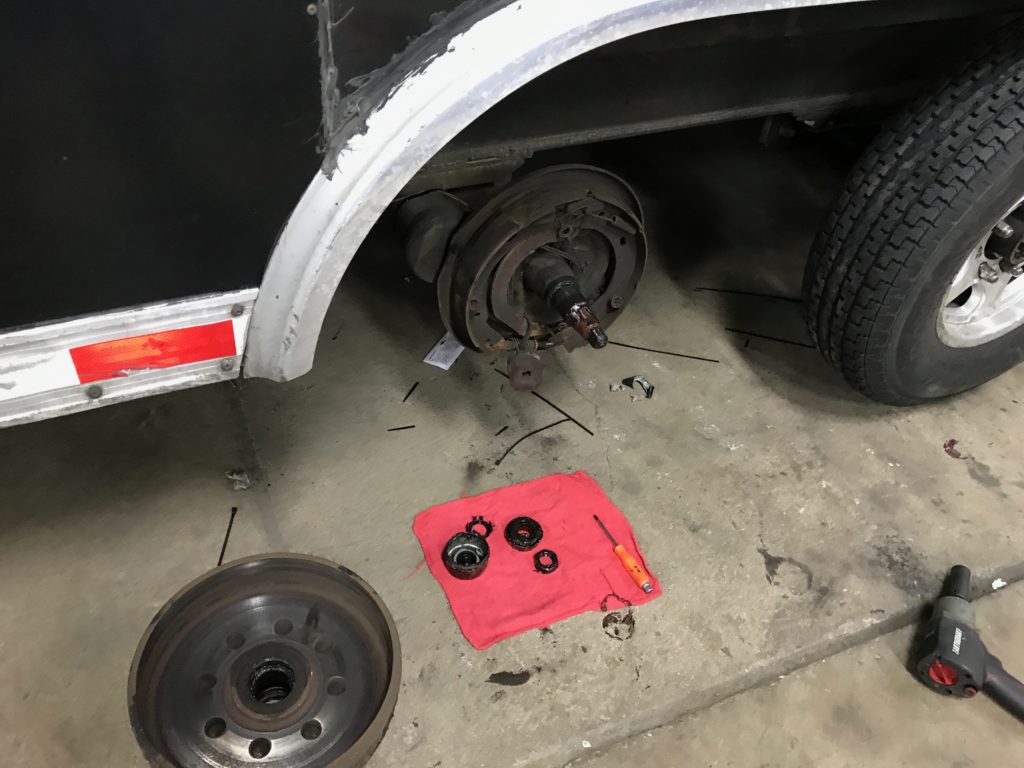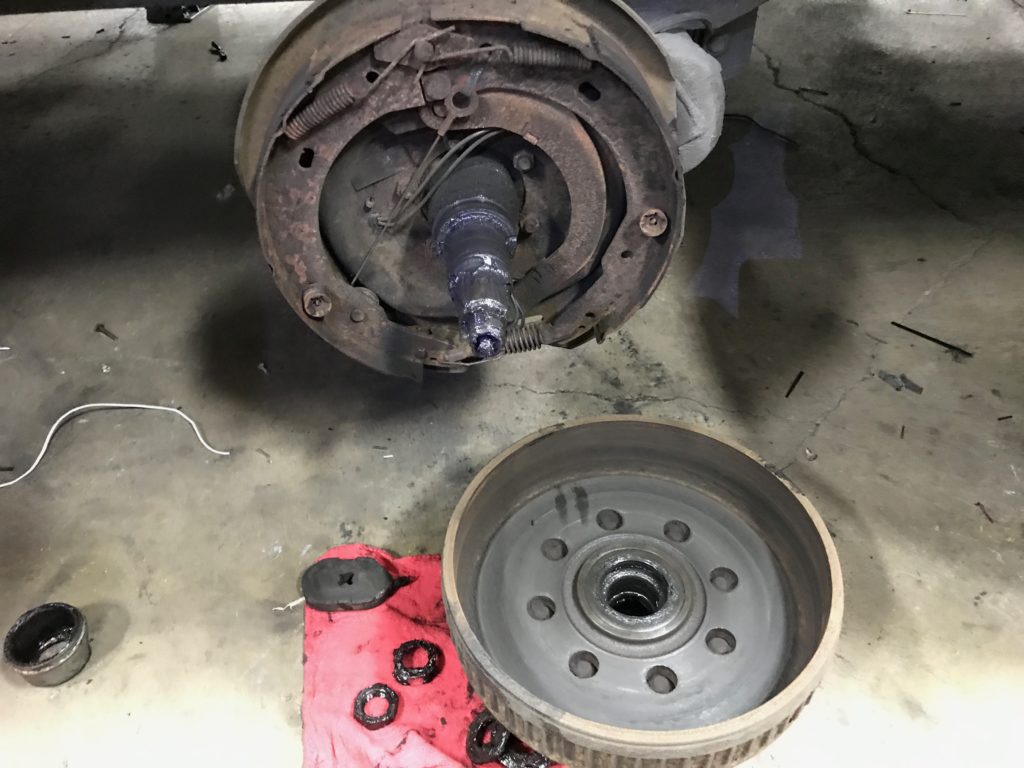
Brakes – even new equipment needs periodic Brakes check up and replacement. This is one of the most important safety component of a truck or a trailer. Brakes are number one priority for us too! Keep your brakes “up to date” and drive safely. Our team can help you change the brakes, replace Brake Seal, perform Brake Adjustment, change tire bearing, drums and many more. Our mechanics do their job quickly and accurately, so you don’t have to wait for days, or fix same problem twice.
Stop Safely: 8 Essential Truck Brake Maintenance Tips:
Road warriors, it’s about time to think about replacing your truck and trailer’s brakes. Spring is a busy time for performing important brake maintenance after heavy road use during winter months. Road de-icing chemicals cause serious corrosion and damage to your brake linings and drums.
No matter if you have a heavy brake application truck or if you’re steering an over-the-road truck with less heat on brakes, your truck needs to be closely monitored for shoe lining wear and correct lubrication. Drums and shoes should be replaced per the Department of Transportation’s recommended specifications for mileage wear.
To get you through the tough winter months to your spring truck brake maintenance appointment, here are a few maintenance tips to ensure your truck and your trailer stop safely.
Tip 1: Check Brake Linings and Hoses
Brake linings can go through tough use, and often they are the first part of the brake parts that need replacement. Linings must not be loose or soaked with oil or grease, and should be replaced if wearing thin below ¼ of an inch. Also, monitor your air hoses connected to the brake areas to ensure proper attachment and to check if any wear issues are occurring.
Trailers that have been exposed to weather elements can suffer from corrosion, and moisture getting into the brake system will impact lines—and can cause brakes to freeze. This means trailers can be dragged (especially when empty) and damage trailer tires, so careful inspection of trailers is also necessary for safety when stopping
Tip 2: Replace Brake Shoes Consistently
Many truck brake shoes come with replacement indicators warning drivers and truck maintainers when parts are wearing down. A best practice is to replace all necessary brake parts at the same time when you schedule your maintenance to ensure life-spans of parts are similar. If replacing brake shoes, also replace other interrelated parts like brake drums, which can wear and crack due to heat use, along with heavy duty hardware kits, which include bushings, pins, and springs.
Tip 3: Inspect Wheels and Brake Chambers
Wheels in service need to be inspected at regular intervals to assure proper and safe brake performance. Examine all exposed areas frequently. Clean wheels and look for cracks, corrosion, wear, or other damage. Also, check the inner dual wheel when the outer wheel is removed. Common crack areas will be from bolt hole to bolt hole, handhole to handhole, or handhole to bolt hole. These type of cracks are usually caused by overloading.
Visually inspect air chambers to ensure they are not damaged, hanging loose, or have broken push rods. Compression spring fracture is the major cause of all spring brake failures. Water, salt, oil, and other contaminants attack and weaken the spring causing corrosion and ultimately, failure. Chambers should be replaced in pairs to keep good brake balance on the axle. Never mix and match long stroke and standard chambers—and check torque on mounting bolts.
Tip 4: Know When to Replace Bearings
Bearing maintenance is an important component for brake maintenance. Early detection of wheel-end problems can save your truck or trailer from unnecessary downtime and costly emergency roadside repairs. Bearing damage may have already begun if you notice the following happening with your truck:
-
Abnormal or uneven tire wear
-
Smoking or extremely hot hub cap (too hot to touch)
-
Wheel seal leakage
-
Wheel vibration, wobble, or noise
-
Increased stopping distance or decreased braking power
-
Abnormal side pull when brakes are applied
-
Wheel lock-up or skidding
If your truck is suffering from these symptoms, bring it in for immediate inspection to see if bearings need replacement. Braking power is never a truck function that should be compromised, and continued increases in required stopping distances put drivers and traffic in potential jeopardy.
Tip 5: Maintain Correct Air Pressure Levels
Correct air pressure ensures proper brake use. If your truck’s gauge is running under 60 psi before you start driving, this is a good indicator you need to check your brakes or your gauge to make sure everything is in order. A truck should not be driven if your air pressure is registering this low. Pressure should run between 100 psi and 125 psi, and low pressure means brakes need to be serviced.
Tip 6: Grease Slack Adjusters and S Cams
Proper lubrication makes a world of difference for the lifespan of your slack adjusters and S cams (which push the shoe into the drum for stopping motion). This maintenance tip keeps brakes in alignment, and supports both automatic or manual slack adjusted brakes. Manual slack adjusters are often greased, but sometimes automatic slack adjusters are forgotten because of inconsistent use. Proper greasing of automatic and manual slack adjusters ensures brakes don’t seize or lead to brake failures.
Tip 7: Inspect Anti-Lock Braking System
Although some anti-lock braking systems (ABS) generally require no routine maintenance, it should be checked periodically like other components of the air brake system. Some commonly encountered problems that trigger ABS malfunctions include:
-
Abraded or cut wires in convoluted tubing near frame clamps
-
Cut or corroded wires near sharp frame members and frame-mounted modulators
-
Wire jacket worn through from overlapping sensor and modulator wires
-
Corroded connectors and connections not properly sealed or damaged seals
-
Damaged connector latches or connectors not completely sealed to mating assemblies
-
Terminals not completely latched or seated into connectors
-
Excessive sensor air gap, sensor clip tension, or excessive wheel bearing endplay
-
Damage to exposed wires exiting or entering wire tubing
-
Worn, chipped or damaged sensor or modulator
-
Non-functioning controller (ECU)
Tip 8: Monitor Air Dryers Every Month
It’s important to protect your truck’s air system from contamination because multiple on-vehicle technologies use this air. The air dryer collects and removes solid, liquid, and aerosol contaminants—such as water and oil—before they enter the air brake system and jeopardize efficient truck operation.
Interval requirements depend on the vehicle’s age, compressor condition, operating environment, vehicle vocation, and usage. Fleets can determine correct filter functionality by checking for moisture in the air brake system monthly. If moisture is present, the air dryer cartridge may require replacement. Using a well-operating air dryer and cartridge helps fleet owners lower operating costs.
Need to schedule your truck or fleet’s spring brake maintenance? Contact us to schedule your appointment! Also, check out truck part specials on all the items you need for the winter months.
Visit us today!




Source: https://wheelco.com/blog/2017/stop-safely-8-essential-truck-brake-maintenance-tips/
